Marine resources - Western Central Pacific|
| Fact Sheet Title Fact Sheet |
| | | Marine resources - Western Central Pacific |
 | All resources in FAO Statistical Area 71 |
| | Data Ownership | | This document owned by Food and Agriculture Organization (FAO), provided and maintained by Marine and Inland Fisheries Branch (FIRF) , is part of FAO Global Marine Fishery Resource Reports data collection. |
| | ident Block | ident Block | | | | Species List: All aquatic species | |
|
| ident Block Marine resources - Western Central Pacific Map tips - Click on
 to turn layers on and off to turn layers on and off - Double-click to zoom in
- Drag to pan
- Hold down the shift key and drag to zoom to a particular region
| fao Major |
|---|
| 71 | Pacific, Western Central |
|---|
|
|
|
|
| | Aq Res | Biological Stock: No Value: Regional
Management unit: No Reference year: 2009
|
| Considered a management unit: An aquatic resource or fishery is declared as [Fishery] Management Unit if it is effectively the focus for the application of selected management methods and measures, within the broader framework of a management system. According to the FAO Glossary for Responsible Fishing, "a Fishery Management Unit (FMU) is a fishery or a portion of a fishery identified in a Fishery Management Plan (FMP) relevant to the FMP's management objectives." FMU's may be organised around fisheries biological, geographic, economic, technical, social or ecological dimensions , and the makeup and attribute of a fishery management unit depends mainly on the FMP's management objectives. |
| Jurisdictional distribution: Jurisdictional qualifier (e.g. "shared", "shared - highly migratory") of the aquatic resource related with its spatial distribution. |
| Environmental group: Classification of the aquatic resource according to the environmental group (e.g. pelagic invertebrate, or demersal fish) to which the species belong. |
| Reference Year: The Reference Year is the last year considered in the stock assessment and/or fishery status. |
| | | | | | Aq Res State Trend To access all FIRMS State and Trend summaries available for this Area, please look at: Status and Trend Summaries (extracted from reports)Trawling has spread throughout the region to most areas with shallow shelf waters, alongside pushnetting-type gears. Consistent with the trends in overall catches of the different groups of coastal fish resources, the majority of stocks are now considered to be at least fully exploited in the east of Area 71 (e.g. Indonesia, Malaysia, the Philippines and Thailand). Some species (e.g. threadfin bream and pony fish) are targeted for surimi production and considered to be overfished at least in some places (e.g. Thailand). Substantial quantities of several other species groups such as lizardfishes and goatfishes are also used for surimi production. For example, in Thailand, production of surimi exceeded 300 000 tonnes in 2007, corresponding to about 1.2 million tonnes of unprocessed fish (Lymer, Funge-Smith and Miao, 2010). For the invertebrate groups, the crustacean (shrimp and crabs) and cephalopod (squid and cuttlefish) resources are considered to be at least fully fished, but overfished in one or more of the countries (e.g. Thailand and Cambodia; FAO, 2010). Coastal resources, South East Asia Shrimp fisheries are important in this region, with Indonesia, Viet Nam, Thailand, Malaysia, the Philippines and Australia being the main producing countries. In 2009, Indonesia reported 150 000 tonnes of shrimp (ISSCAAP Group 45) and Viet Nam 127 000 tonnes. After China and India, Indonesia’s shrimp catch is the largest in the world. However, shrimp fishing generates a multitude of conflicts, most of which involve small-scale fisheries. The effectiveness of the 1980s trawl ban in Indonesia waters has been eroded and, today, there are countless boats that catch shrimp using many types of fishing gear, a situation exacerbated by illegal activity and poor statistical information (Gillett, 2008). In the south of the region, there are important shrimp fisheries to the south of Timor-Leste that are exploited by Indonesia and Australia. Shrimps, Arafura Sea Shrimp fisheries in the Arafura Sea exploit various species of penaeid shrimp but the major species includes banana shrimp ( Penaeus merguiensis) and various species of the genus Metapenaeus, particularly M. endeavouri and M. ensis, which are considered to be depleted. Shrimps, northern territory of Australia The shrimp fisheries off the Northern Territory and in the Gulf of Carpentaria in Australia also exploit banana shrimp, white shrimp ( P. indicus), brown tiger shrimp ( P. esculentus) and grooved tiger shrimp ( P. semisulcatus) and a number of other species with a total catch in 2009 of 5 200 tonnes and a value of US$74 m. The main shrimp stocks and fishing levels are considered to be at acceptable levels (BRS, 2010). Habitat Bio Climatic Zone: Tropical. Water Area Overview FAO Statistical Area 71 covers 33.9 million km 2 and extends from the seas of Southeast Asian countries down to north and east Australia. It also covers the area further east to some of the smaller island countries of the South Pacific (Figure B12.1). Area 71includes the South China Sea, Sulu-Celebes Sea, Arafura Timor Sea and the Gulf of Thailand as well as a significant amount of open ocean on the western side. More than half of this area covers a large continental shelf (6.6 million km 2) that is bordered in the north by Southeast Asian countries and in the southeast by Indonesia and Australia. The majority of this the shelf lies within the EEZs of Southeast Asian countries, and this is reflected in the major contribution these countries make to the total production of Area 71. 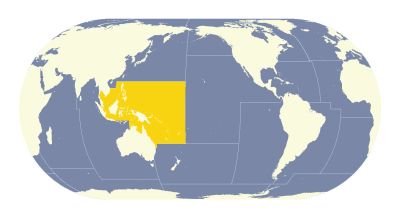 | Figure B12.1 The Western Central Pacific (Area 71)  |
The region is characterized by a complex geomorphology, making this region one of the most highly diverse marine areas in the world, including continental, island and archipelagic countries. The Indonesian and Philippine archipelagos comprise more than 7 000 islands. The coastlines of each of these two countries covers 54 716 km and 36 289 km, respectively. The Gulf of Thailand is a large shelf area with a maximum depth of about 80 m and a tropical climate governed by the monsoon regime. This is a highly productive area, mainly because of the high nutrient input coming from the rivers discharging into the Gulf of Thailand. However, its fishery resources are severely overexploited (Kongprom et al., 2003), and by 1995 biomass levels were already less than 10 percent of the biomass in the early 1960s. Reported production for the area still seems to be rising, although this is probably a reporting effect of catches from other fishing areas, as fishery assessments indicate clear overfishing effects. Moving eastwards, the less productive South China Sea also has a tropical climate influenced by the monsoon seasons. Productivity is relatively stable in this region, with limited seasonal and interannual variability. The region is well known for its high marine shallow-water biodiversity. The South China Sea has stocks of marine pelagic species that are exploited for a variety of uses. Despite the increases in reported catches (see below), the fishery resources of this region are also considered to be overexploited. In some cases, these resources are also heavily depleted. The Sulu- Celebes Sea, bordered by Malaysia, Indonesia and the Philippines is also highly diverse with many species found in the extensive coral ecosystems. In terms of capture fisheries, this region is not highly productive. The reefs provide fish for local consumption, and the region is exploited for live reef fish and marine ornamental trade. The high marine diversity here is threatened by a number of human-induced factors (overfishing, use of poison and dynamite fishing) and pollution. It is also threatened by extreme weather events, such as the two warm events of 1988 and 1998 that resulted in widespread coral bleaching and restructuring of coral communities. During the southwest monsoon months, the northern and central parts are affected by revolving tropical storms (typhoons) from the Pacific Ocean, bringing intense rains and destructive winds. Water Area Overview  | | Water Area Overview Marine resources - Western Central Pacific
| fao Major | 71: Pacific, Western Central |
| | | | | | Water Area Overview |
Water Area OverviewMarine resources - Western Central Pacific | fao Major | 71: Pacific, Western Central | | Large Marine Ecosystem Areas (LME) | 34: Bay of Bengal | | 35: Gulf of Thailand | | 36: South China Sea | | 37: Sulu-Celebes Sea | | 38: Indonesian Sea | | 39: North Australian Shelf | | 40: Northeast Australian Shelf/Great Barrier Reef | | 41: East-Central Australian Shelf |
Aq Res Struct Biological Stock: No Exploit The Indonesian Sea is bordered by Indonesia and Timor-Leste. This sea is characterized by complex and strong currents, as the main water exchange between the Pacific and Indian Oceans takes place in this region. Productivity is high owing to the vertical currents (upwellings) that take place as a result of the monsoon winds. Fisheries include both artisanal as well as industrial operations. Despite increasing reported landings in this region in past decades, there is evidence of resources being overexploited, well beyond their biological limits (Dwippongo et al., 1987). Moreover, pollution from urban centres and from agriculture activities as well as siltation from deforestation and mining all result in major negative impacts on the marine environment and its resources. The north and northeast Australian shelves make up the remainder of Area 71. Productivity is high along the northern coasts, mainly because of tidal mixing but also as a result of monsoon winds and tropical cyclones. This region is connected to the Indonesian Sea by the Indonesian Throughflow that brings warm Pacific water into the Indian Ocean. The marine fauna consists of species common to the Indo-Pacific. There are very few examples of resources being depleted, but most stocks are fully exploited. The main fishery resources in the coastal areas of Area 71 include small pelagics (about 3 million tonnes) various demersals (with penaeid shrimps probably being the most economically valuable), and invertebrates (1.3 million tonnes) as well as a significant, large category of non-identified fish. The oceanic waters of the Western Central Pacific have large tuna resources, with catches of 2.9 million tonnes. Total catches of Area 71 increased steadily from 1950 to 2003, when the catch reached nearly 11 million tonnes. Since then, the catches have stabilized with 11.2 million tonnes caught in 2009. The majority of the catch is consumed locally by the large populations present in many of the bordering countries. The major export commodities in Area 71 are tunas and, to a far lesser extent, shrimp. An increasing amount of the low-value catch (including a significant amount of “trash fish” from the trawl fisheries) is now reduced to fishmeal and fish oil or used directly as unprocessed feed for the aquaculture industry. Increasingly, there are efforts to improve the quality and preservation of some of this catch (estimated at more than 300 000 tonnes) and divert it into processing for surimi. Despite the rapid and continued development of fisheries in Area 71, knowledge of the status of the main fish resources is still very poor. The conditions in which fishery administrations operate are extremely challenging, with a very high population density in most coastal areas, a complex geomorphology and very high biological diversity. These conditions make collecting fishery statistics, developing reliable assessments and managing fisheries extremely challenging. While information on catches and status of stocks is poor and highly uncertain, there is some good evidence that major declines in fish productivity have taken place and that these add to the impacts of other land-based activities. PROFILE OF CATCHESThe catches in Area 71 increased steadily from 540 000 tonnes in 1950 to 10.5 million tonnes in 2002 but have stabilized in the last few years with a total catch for 2009 of 11.2 million tonnes (Figure B12.2, Table D14). The five Southeast Asian countries (Indonesia, Malaysia, the Philippines, Thailand and Viet Nam) continued to contribute more than 85 percent of the total catch from 2002 through to 2009. These are largely tropical multispecies coastal fisheries with a large component of unidentified marine fish (ISSCAAP Group 39). The largest single component of the catch for Area 71 is now the tunas, bonitos and billfish (ISSCAAP Group 36), which increased from 22.3 percent of the catch in 2002 to 26.1 percent of the total in 2009. 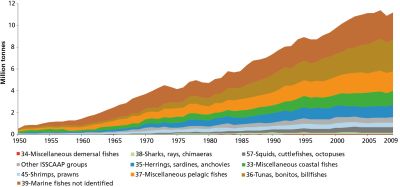 | Figure B12.2 Annual nominal catches by ISSCAAP species groups in the Western Central Pacific (Area 71)  |
The catches of tuna and billfish in this region now form the largest tuna fishery in the world and are an extremely important export commodity for many countries in the region (Figure B12.3). The catch of skipjack tuna has increased rapidly in the past 30 years following the introduction of large purse seine vessels. The catch rose from less than 100 tonnes in 1970 to more than 1 million tonnes in 2002 and further increased to 1.6 million tonnes in 2009. The catch of yellowfin tuna in this region has fluctuated around an average of 400 000 tonnes for the past ten years. While the catches of the other tuna, bonitos and billfishes have increased, the reported catch of tuna-like species has declined. This may represent improved catch reporting as a result of the increased observer coverage and training now occurring in many of these fisheries. The catch of the more coastal kawakawa has also declined in the last six years, from a peak of 277 000 tonnes in 2002 to 179 000 tonnes in 2009 (Figure B12.3). The other main components of the catch include: miscellaneous pelagic fishes (ISSCAAP Group 37) at 16 percent; miscellaneous coastal fishes (ISSCAAP Group 33) with 11.1 percent; and herrings sardines, anchovies (ISSCAAP Group 35) with 10.4 percent. Shrimps, prawns (ISSCAAP Group 45) and cephalopods (ISSCAAP Group 57) only constitute 3.6 and 4.6 percent of the total, respectively. Despite their small contribution to the total catch, both these groups are economically important to the countries in this region. 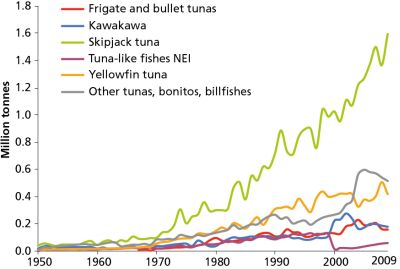 | Figure B12.3 Annual nominal catches of selected species in ISSCAAP Group 36, Western Central Pacific (Area 71)  |
There has been no overall increase in the catch of scads and other groups in the miscellaneous pelagic group (ISSCAAP Group 37), and even a slight decrease in recent years. Similarly, for herring, sardine and anchovy (ISSCAAP Group 35), the catches of the group, which include Sardinella gibbosa and Stolephorus anchovies, has been relatively stable for the past 15 years except for the slight increase observed in 2009 (Figure B12.4). While the overall catch of the miscellaneous coastal fishes (ISSCAAP Group 33) has continued to increase, the catches of some key components such as threadfin bream have shown sharp reductions in the last few years as have those of sharks, rays and skates (ISSCAAP Group 38, Figure B12.5). 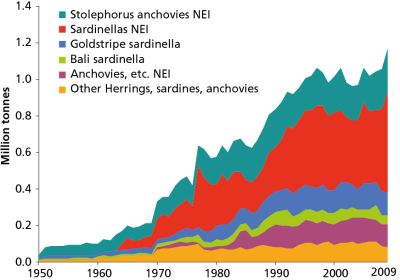 | Figure B12.4 Annual nominal catches of selected species in ISSCAAP Group 35, Western Central Pacific (Area 71)  |
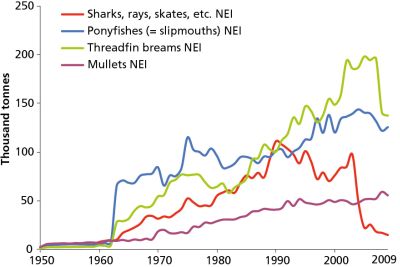 | Figure B12.5 Annual nominal catches of selected species in ISSCAAP Groups 33 and 38, Western Central Pacific (Area 71)  |
Except for the catch of natantian decapods, which has remained at or near 200 000 tonnes for the past eight years, most of the shrimp and prawn catches have declined in the past decade. These declines have led to a lowering of the overall catch of this group (ISSCAAP Group 45) from 460 000 tonnes in 2002 to 405 000 tonnes in 2009 (Figure B12.6). The total catch of cephalopods (ISSCAAP Group 57) has only increased slightly from 496 000 tonnes caught in 2002 to 506 000 tonnes in 2009, which was generated by the rapid increase in catch of the other squids, octopus and cuttlefish component (Figure B12.7). 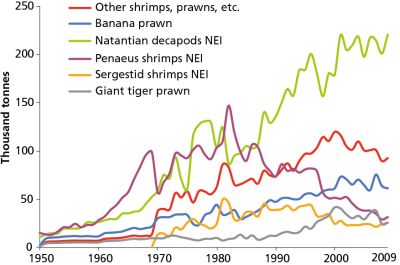 | Figure B12.6 Annual nominal catches of selected species in ISSCAAP Group 45, Western Central Pacific (Area 71)  |
 | Figure B12.7 Annual nominal catches of selected species in ISSCAAP Group 57, Western Central Pacific (Area 71)  |
High seasThe catches (mostly of tuna and tuna-like species) reported by distant-water nations fishing in Area 71 have been relatively stable at between 700 000 tonnes and 1 million tonnes for the past 20 years (Figure B12.8). However, these values may not include all the catches of tuna made by these countries. They are only reported as part of any access agreements to fish within the EEZs of countries in Area 71 (especially small island States) or where their vessels are actually licensed by one of these member countries. Methods to control the level of tuna fishing in the “high seas pockets” that are not contained within the EEZ of member countries are being actively pursued by the WCPFC, including the closure of some of these areas to tuna fishing by member countries. 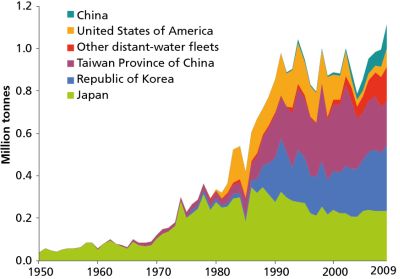 | Figure B12.8 Annual nominal catches of distant-water countries' fleets, Western Central Pacific (Area 71)  |
Bio Assess A recent stock assessment workshop for South and Southeast Asia (FAO, 2010) indicated that many of the coastal fish resources in this region continue to be under increasing fishing pressure and that many of these resources are fully exploited or overexploited. The development of trawl fishing in the Gulf of Thailand in the 1960s resulted in the overexploitation of demersal resources. The most recent stock assessments suggest that this status has not changed (FAO, 2010, Table D14). An overall regional assessment carried out utilizing the landing statistics available in FAO FishStat, resulted in most of the species and species groups (77 percent) being assessed as fully exploited. Another 7 percent of the species or species groups were found to be non-fully exploited and 15 percent were overexploited. Sharks and rays were the most prominent overexploited groups (regional landings falling below 50 percent of the highest three-year average). These results appear to be more optimistic compared with independent information available for some of the regions. Data available from the scientific surveys (e.g. Silvestre et al., 2003) show a situation of local depletions already by the 1990s. For example, in the Gulf of Thailand, by the mid-1990s, demersal biomass had declined to 8 percent of the level found in the early 1960s (Kongprom et al., 2003). Similarly, analyses carried out on surveys in Peninsular Malaysia and Sarawak from 1972 to 1998 indicate widespread overexploitation and depletion of resources (Ahmad et al., 2003). These reports are not consistent with the relatively positive impression that can be gained from the catch statistics and relative assessments. It is reasonable to think that widespread misreporting of catches may exist. Information on trends in CPUEs from a number of countries in the region seems to be consistent with the information derived from the research surveys. As an example, annual CPUEs decreased in Viet Nam from 1.12 tonnes/hp in 1985 to 0.3512 tonnes/hp in 2003. In Indonesia, a substantial decrease has been observed for the period 1990 to 2007 in otter/pair trawling, purse seining and gillnetting. In Thailand, where resources were considered to be overexploited already by the mid-1990s, an additional drop in the CPUEs has been observed for the period from 1997 to 2002 as regards both otter/pair trawling (–8 percent) and purse seining (–35 percent) (Lymer, Funge-Smith and Miao, 2010). The stock status of the tuna resources in the Western and Central Pacific Ocean (WCPO) are regularly assessed by the Scientific Committee of the WCPFC, and their status is reported at the annual meeting. The latest assessments (WCPFC, 2011) suggest that the WCPO skipjack stock is at a moderate level of depletion and there is no overfishing. Similarly, for south Pacific albacore tuna, the current level of depletion is considered moderate and current catches are sustainable. The overall level of depletion of the WCPO yellowfin stock is considered to be at a moderate level. However, this depletion is much greater in the western equatorial zone where most of the purse seine catches occur. Therefore, the WCPFC has recommended no increase in the catch of this species. For bigeye tuna, there is debate whether the very high level of depletion can be considered overfishing or not, but the WCPFC has recommended a minimum 29 percent cut in the fishing mortality for this stock. Management Management unit: No Management of these shrimp fisheries is rather diverse. In Australia, restricted entry began in the late 1960s. The fishery is managed jointly by the Government and industry through the Prawn Fisheries Management Committee headed by an independent chair. The fishers themselves take an active role in research by participating in stock assessments using their vessels and crew (Gillett, 2008). However, in many other fisheries, the number of shrimp trawlers has increased under an essentially open-access regime with no formal management plans in place. Despite the lack of economic data on shrimp fishing, there are indications that, in many cases, both the profitability of individual shrimp fishing operations and the rent from the various shrimp fisheries are low. A rising proportion of trash fish and falling CPUEs are observed in many fisheries (Gillett, 2008). Many of the countries within Area 71 have established fishery zones and/or management areas. These vary between zones established to separate coastal small-boat fisheries from larger-powered vessels, and larger zones delineated according to provincial or other political boundaries or fishing areas. Despite this zoning, considerable problems remain with the enforcement of measures, owing to weak MCS systems. In response to this, Indonesia and Malaysia have developed wheelhouse marking schemes to provide quicker visual indications of whether a vessel is operating in the right zone or not. In the north of Area 71, apart from Malaysia, the use of limited-access management arrangements is not common, with gear and area restrictions being the most frequently used controls. In the south of Area 71, restrictions on effort, catch, gear, etc. using scientific advice within a rights-based framework have been integral to the fishery management process in Australia for some time. Countries in the south and southeast Asian waters of Area 71 are becoming increasingly aware of the need for sustainable management of their marine resources. However, considerable effort is still required to implement appropriate management regimes. The most common management measures in this region includes zoning by fishing gear, closed season, closed area and mesh size limit. Malaysia has a formal fisheries development process as part of its National Agricultural Plan of 1992–2010 and is the most progressive and advanced country in this respect. This is one of the few countries to have policy statements in management strategies that recommend implementation of limited access, conservation measures or the establishment of sustainable harvesting limits (Flewwelling and Hosch, 2007). Advice There are a number of regional bodies that operate on fishery issues in this region: World Fish Center (WFC), Southeast Asian Fisheries Development Center (SEAFDEC), Association of Southeast Asian Nations (ASEAN) Fisheries Working Group, Asia-Pacific Economic Cooperation (APEC) Fisheries Working Group, and the FAO Asia-Pacific Fishery Commission (APFIC). All of these bodies play a major role in technical training; in addition, they assist members in the development of individual fishery management plans. Given the different priorities within countries, these management tools have been fully or partially implemented, yielding varying degrees of progress towards these management goals (Flewwelling and Hosch, 2007). The offshore waters of the Western Central Pacific (Area 71) have come under increased management control through the establishment of the WCPFC in June 2004. The 15 small island States in this region depend strongly on these resources. Despite the rise in catches in the last decade, this small island group still accounts for only 4.1 percent of total catch of the region (discussed in detail in Chapter C3). A significant proportion of the catch of tuna within these countries’ EEZs is taken by vessels of distant-water fishing nations. These access arrangements and other registration schemes are negotiated with the assistance of the Forum Fisheries Agency (FFA) and more recently the Parties to the Nauru Agreement. The distant-water fleets fishing in this region include those China, Japan, the Republic of Korea, Taiwan Province of China, and the United States of America. In total, catches by vessels flagged as distant-water fishing nations contributed to 8.7 percent of the total production of the Area 71. The WCPFC has the mandate and authority to implement the Convention for the Conservation and Management of Highly Migratory Fish Stocks (Anon., 2000) in the WCPO. The convention entered into force on 19 June 2004 and covers almost 20 percent of the Earth’s surface. Although the western boundary notionally extends to the East Asian seaboard, it is understood that the convention area does not include the South China Sea. The WCPFC has 25 member countries, a number of participating territories and 9 cooperating non-members under this convention. It seeks to ensure the long-term conservation and sustainable use of the tunas, billfish and marlin in the WCPO. It does this by developing conservation and management measures that cover target, non-target and bycatch species associated with the tuna fisheries operating in the region. The WCPFC works in cooperation with the FFA to establish effective licensing, compliance systems and observer coverage along with the Secretariat of the Pacific Community (SPC), which is the main science provider and data manager. Sources Marine and Inland Fisheries Service, Fisheries and Aquaculture Resources Use and Conservation Division. FAO Fisheries and Aquaculture Department “Review of the state of world marine fishery resources” FAO FISHERIES AND AQUACULTURE TECHNICAL PAPER. No. 569. Rome, FAO. 2011.  http://www.fao.org/docrep/015/i2389e/i2389e.pdf http://www.fao.org/docrep/015/i2389e/i2389e.pdf Bibliography The bibliographic references are available through the hyperlink displayed in "Source of Information". ACKNOWLEDGEMENTSThe authors wish to thank Simon Funge-Smith (FAO Regional Office for Asia and the Pacific) for his thorough review of the initial draft and for providing valuable additional information. |
|
| |
|
|





